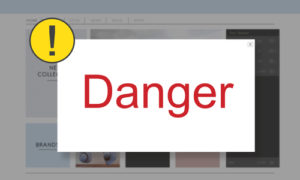Google’s Pop-up Restrictions – Is Your Site Safe?

With 2016 reigning large as the year of indecipherable algorithm updates, it was almost refreshing to hear about its clearly delineated “intrusive interstitials” penalty. In August of 2016, Google announced that it would begin rolling this out in early 2017. The guidelines were fairly clear (at least at first glance) – mobile site designs with obnoxious pop-ups or overlays that interfered with the user experience would experience penalties.
Now that we’re past the update rollout, we’re left wondering: what happened, exactly? The uncertainty comes from the lack of penalties faced by even sites with problematic pop-ups. Webmasters are reporting little to no impact on rankings, no matter the state of their interstitials. So is it time to learn back and relax? Not quite.
As always with SEO, we want to be proactive. Learning more about what kind of design practices Google is trying to dissuade (and why they’re cracking down on pop-ups) is a perfect intermediary activity while we wait for the full effects to take hold. Read on for what this could mean for your dental website.
What Google Does – And Doesn’t – Want You to Serve Your Website Visitors
Pop-ups are useful for many different reasons – announcing flash sales or other eCommerce opportunities, presenting visitors with a newsletter or eBook signup, or providing live chat support. But the ways in which each website provides this content can vary wildly. There’s an unbelievable difference between a respectful pop-up that can be easily closed, and one that blocks out all navigation and refuses to budge until you’ve promised it your firstborn child.
This is doubly true on mobile. The screen you’re working with is a small one – there’s just not enough real estate there to allow for both pop-ups and navigability. This is why Google is taking this newest step in its battle to make the internet a higher-quality, user-driven experience. As the ruler of all we do (lest we make a misstep and be banished to the long-distance rankings tier), Google is working harder and harder to make websites more friendly. If the user is irritated, Google isn’t going to look fondly on that domain.
The intrusive interstitials rule doesn’t outlaw pop-ups entirely – rather, it dictates their size and their annoyingness factor. Take a look at the graphic below to see Google’s official statement on the update:
In short, as long as the pop-ups don’t detract from navigation or cover the content that the user is hoping to access, they’re ok. We’ve seen live chat providers change chat boxes from mid-screen and floating to a small ribbon at the bottom of the mobile browser.
Why Do Dental Websites Benefit from Pop-Ups?
Wondering why any healthcare professionals like yourself would be using pop-ups? In truth, live chat features are becoming more and more popular on medical websites. This is a great way to capture leads who aren’t quite ready to fill out a contact form, but are interested in learning more about your practice. Many chat providers are fairly inexpensive and will provide basic information to the user before forwarding their inquiry and information to your front desk.
More competitive practices like med spas and cosmetic dentists can also make good use of pop-ups to provide newsletter access. Lock visitors into your email campaigns, and you have a much higher chance of re-engagement (and future business) down the road.
Whether your site design currently makes use of interstitials or not, the pros and cons are plenty. Overall, pop-ups can be a useful tool for engaging site visitors at the beginning of the buyer’s journey – just make sure those pop-ups don’t annoy them along the way.
Looking for help with your site design? Worrying that your website interface isn’t pulling in leads the way it should? Reach out today for a complimentary website evaluation. We’d love to help you move forward & take your practice to the next level!
